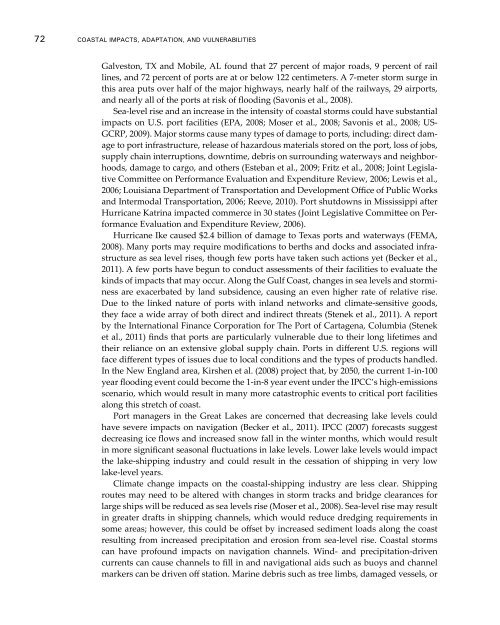Coastal Impacts, Adaptation, and Vulnerabilities - Climate ...
Coastal Impacts, Adaptation, and Vulnerabilities - Climate ...
Coastal Impacts, Adaptation, and Vulnerabilities - Climate ...
Create successful ePaper yourself
Turn your PDF publications into a flip-book with our unique Google optimized e-Paper software.
72 <strong>Coastal</strong> <strong>Impacts</strong>, <strong>Adaptation</strong>, <strong>and</strong> <strong>Vulnerabilities</strong>Galveston, TX <strong>and</strong> Mobile, AL found that 27 percent of major roads, 9 percent of raillines, <strong>and</strong> 72 percent of ports are at or below 122 centimeters. A 7-meter storm surge inthis area puts over half of the major highways, nearly half of the railways, 29 airports,<strong>and</strong> nearly all of the ports at risk of flooding (Savonis et al., 2008).Sea-level rise <strong>and</strong> an increase in the intensity of coastal storms could have substantialimpacts on U.S. port facilities (EPA, 2008; Moser et al., 2008; Savonis et al., 2008; US-GCRP, 2009). Major storms cause many types of damage to ports, including: direct damageto port infrastructure, release of hazardous materials stored on the port, loss of jobs,supply chain interruptions, downtime, debris on surrounding waterways <strong>and</strong> neighborhoods,damage to cargo, <strong>and</strong> others (Esteban et al., 2009; Fritz et al., 2008; Joint LegislativeCommittee on Performance Evaluation <strong>and</strong> Expenditure Review, 2006; Lewis et al.,2006; Louisiana Department of Transportation <strong>and</strong> Development Office of Public Works<strong>and</strong> Intermodal Transportation, 2006; Reeve, 2010). Port shutdowns in Mississippi afterHurricane Katrina impacted commerce in 30 states (Joint Legislative Committee on PerformanceEvaluation <strong>and</strong> Expenditure Review, 2006).Hurricane Ike caused $2.4 billion of damage to Texas ports <strong>and</strong> waterways (FEMA,2008). Many ports may require modifications to berths <strong>and</strong> docks <strong>and</strong> associated infrastructureas sea level rises, though few ports have taken such actions yet (Becker et al.,2011). A few ports have begun to conduct assessments of their facilities to evaluate thekinds of impacts that may occur. Along the Gulf Coast, changes in sea levels <strong>and</strong> storminessare exacerbated by l<strong>and</strong> subsidence, causing an even higher rate of relative rise.Due to the linked nature of ports with inl<strong>and</strong> networks <strong>and</strong> climate-sensitive goods,they face a wide array of both direct <strong>and</strong> indirect threats (Stenek et al., 2011). A reportby the International Finance Corporation for The Port of Cartagena, Columbia (Steneket al., 2011) finds that ports are particularly vulnerable due to their long lifetimes <strong>and</strong>their reliance on an extensive global supply chain. Ports in different U.S. regions willface different types of issues due to local conditions <strong>and</strong> the types of products h<strong>and</strong>led.In the New Engl<strong>and</strong> area, Kirshen et al. (2008) project that, by 2050, the current 1-in-100year flooding event could become the 1-in-8 year event under the IPCC’s high-emissionsscenario, which would result in many more catastrophic events to critical port facilitiesalong this stretch of coast.Port managers in the Great Lakes are concerned that decreasing lake levels couldhave severe impacts on navigation (Becker et al., 2011). IPCC (2007) forecasts suggestdecreasing ice flows <strong>and</strong> increased snow fall in the winter months, which would resultin more significant seasonal fluctuations in lake levels. Lower lake levels would impactthe lake-shipping industry <strong>and</strong> could result in the cessation of shipping in very lowlake-level years.<strong>Climate</strong> change impacts on the coastal-shipping industry are less clear. Shippingroutes may need to be altered with changes in storm tracks <strong>and</strong> bridge clearances forlarge ships will be reduced as sea levels rise (Moser et al., 2008). Sea-level rise may resultin greater drafts in shipping channels, which would reduce dredging requirements insome areas; however, this could be offset by increased sediment loads along the coastresulting from increased precipitation <strong>and</strong> erosion from sea-level rise. <strong>Coastal</strong> stormscan have profound impacts on navigation channels. Wind- <strong>and</strong> precipitation-drivencurrents can cause channels to fill in <strong>and</strong> navigational aids such as buoys <strong>and</strong> channelmarkers can be driven off station. Marine debris such as tree limbs, damaged vessels, or
















